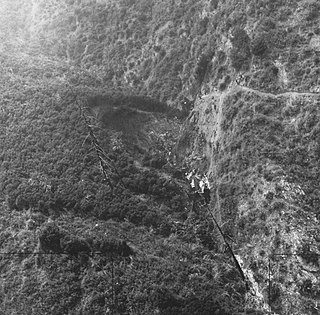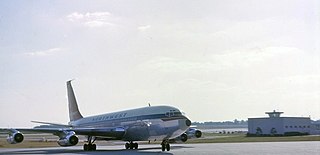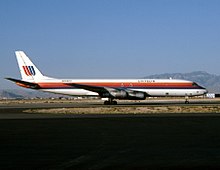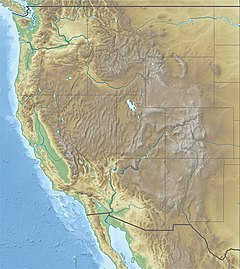
The Tenerife airport disaster occurred on March 27, 1977, when two Boeing 747 passenger jets collided on the runway at Los Rodeos Airport on the Spanish island of Tenerife. The collision occurred when KLM Flight 4805 initiated its takeoff run during dense fog while Pan Am Flight 1736 was still on the runway. The impact and resulting fire killing all on board KLM 4805 and most of the occupants of Pan Am 1736, with only 61 survivors in the front section of the aircraft. With a total of 583 fatalities, the accident is the deadliest accident in aviation history.
Emery Worldwide Airlines was the cargo airline subsidiary of U.S. based Emery Worldwide, and “one of the nation's major cargo airlines”.

Kaysville is a city in Davis County, Utah. It is part of the Ogden–Clearfield metropolitan area. The population was 27,300 at the time of the 2010 census, with an estimated population of 32,390 in 2019.

Salt Lake City International Airport is a joint military/public airport located about 4 miles west of Downtown Salt Lake City, Utah, in the United States. The airport is the closest commercial airport for more than 2.5 million people and is within a 30-minute drive of nearly 1.3 million jobs. The airport serves as a hub for Delta Air Lines and is a major gateway to the Intermountain West and West Coast. The airport sees 343 scheduled nonstop airline departures per day to 93 cities in North America and Europe. It is by far the busiest airport in Utah.
SkyWest Airlines is an American regional airline headquartered in St. George, Utah, United States. SkyWest operates and maintains aircraft used on flights that are scheduled, marketed and sold by a partner mainline airline. The company is contracted by Alaska Airlines, American Airlines, Delta Air Lines, and United Airlines. In all, it is the largest regional airline in North America when measured by fleet size, number of passengers carried, and number of destinations served.

The Linate Airport disaster occurred in Italy at Linate Airport in Milan on the morning of Monday, 8 October 2001. Scandinavian Airlines System Flight 686, a McDonnell Douglas MD-87 airliner carrying 110 people bound for Copenhagen, Denmark, collided on take-off with a Cessna Citation CJ2 business jet carrying four people bound for Paris, France. All 114 people on both aircraft were killed, as well as four people on the ground.

Delta Air Lines Flight 1141 was a scheduled domestic passenger flight between Dallas/Fort Worth, Texas and Salt Lake City, Utah. On August 31, 1988, the flight, using a Boeing 727-200 series aircraft, crashed during takeoff, resulting in 14 deaths and 76 injuries of the 108 on board.

Luxair Flight 9642 (LG9642/LGL9642) was a scheduled international passenger flight from Berlin Tempelhof Airport, Germany, to Luxembourg Findel Airport, Luxembourg, operated by Luxembourg national airline Luxair. On 6 November 2002, the aircraft operating the flight, a Fokker 50 registered as LX-LGB, lost control and crashed onto a field during an attempted landing at the airport. Out of 22 passengers and crew members on board, only two people survived. The crash is the deadliest aviation disaster to occur in Luxembourg.

On August 16, 1987 a McDonnell Douglas MD-82, operating as Northwest Airlines Flight 255, crashed shortly after takeoff from Detroit Metropolitan Airport, about 8:46 pm EDT, resulting in the deaths of all six crew members and 148 of the 149 passengers, along with two people on the ground. The sole survivor was a 4-year-old girl who sustained serious injuries. It was the second-deadliest aviation accident at the time in the United States. It is also the deadliest aviation accident to have a sole survivor.

Continental Airlines Flight 1713 was a commercial airline flight that crashed while taking off in a snowstorm from Stapleton International Airport in Denver, Colorado, on November 15, 1987. The Douglas DC-9 airliner, operated by Continental Airlines, was making a scheduled flight to Boise, Idaho. Twenty-five passengers and three crew members died in the crash.

United Airlines Flight 227 (N7030U), a scheduled passenger flight from LaGuardia Airport New York City to San Francisco International Airport, California, crashed short of the runway while attempting a scheduled landing at Salt Lake City International Airport, Utah, on Thursday, November 11, 1965.

Hughes Airwest Flight 706 was a regularly scheduled flight operated by American domestic airline Hughes Airwest from Los Angeles, California to Seattle, Washington, with several intermediate stops. On Sunday, June 6, 1971, the McDonnell Douglas DC-9 serving as Flight 706 departed Los Angeles just after 6 p.m. en route to Seattle as a McDonnell Douglas F-4 Phantom II of the United States Marine Corps was approaching Marine Corps Air Station El Toro near Irvine at the end of a flight from Naval Air Station Fallon in Nevada. The two aircraft collided in midair over the San Gabriel Mountains near Duarte, killing all 49 aboard the DC-9 and the F-4 pilot; the F-4 radar intercept officer ejected and survived.

United Air Lines Flight 608 was a Douglas DC-6 airliner, registration NC37510, on a scheduled passenger flight from Los Angeles to Chicago when it crashed at 12:29 pm on October 24, 1947 about 1.5 miles (2.4 km) southeast of Bryce Canyon Airport, Utah, United States. None of the five crew members and 47 passengers on board survived. It was the first crash of a DC-6, and at the time, it was the second-deadliest air crash in the United States, surpassed by Eastern Air Lines Flight 605 by only one fatality.

Alaska Airlines Flight 1866 was a regularly scheduled passenger flight operated by Alaska Airlines from Anchorage, Alaska, to Seattle, Washington, with several intermediate stops in southeast Alaska. The aircraft was a Boeing 727-100 with U.S. registry N2969G manufactured in 1966. On September 4, 1971, the aircraft operating the flight crashed into a mountain in Haines Borough, about 18 miles west of Juneau, Alaska, while on approach for landing. All 111 people aboard were killed. The subsequent investigation found that erroneous navigation readouts led the crew to descend prematurely. No definitive cause for the misleading data was found. It was the first fatal jet aircraft crash involving Alaska Airlines, and remained the deadliest single-aircraft accident in United States history until June 24, 1975, when Eastern Air Lines Flight 66 crashed. It is still, however, the worst air disaster in Alaska state history.

Grand Canyon Scenic Airlines is an American regional airline based in Paradise, Nevada, United States. It operates sightseeing flights from Boulder City Municipal Airport in Boulder City, Nevada. Scenic has been owned by Grand Canyon Airlines since 2008.

Northwest Orient Airlines Flight 705 was a scheduled passenger flight operated on February 12, 1963, that broke up in midair and crashed into the Florida Everglades shortly after takeoff from Miami International Airport in a severe thunderstorm. The plane was destined for Portland, Oregon, via Chicago, Spokane, and Seattle.

Ozark Air Lines Flight 809 was a regularly scheduled flight from Nashville, Tennessee, to St. Louis, Missouri, with four intermediate stops. On July 23, 1973, while landing at St. Louis International Airport, it crashed, killing 38 of the 44 persons aboard. A severe downdraft, associated with a nearby thunderstorm, was cited as the cause.

On Thursday, January 15, 1987, SkyWest Airlines Flight 1834, a Swearingen SA-226TC, and a Mooney M20 were involved in a midair collision at 12:52 MST (UTC−7) near Kearns, Utah, a suburb southwest of Salt Lake City. All ten aboard the two aircraft were killed: two pilots and six passengers aboard the METRO II and two aboard the Mooney.

On May 21, 2000, a British Aerospace BAe-3101 Jetstream 3101 operated by East Coast Aviation Services crashed into mountainous terrain in Bear Creek Township, Wilkes-Barre, Pennsylvania. The plane was carrying 17 professional gamblers returning home from Caesar's Palace Casino in Atlantic City, New Jersey, along with 2 crew members. It was chartered by Caesar's Palace. All 19 passengers and crews on board were killed on impact. This accident, alongside the accident of Aerocaribe Flight 7831 were the accidents with the most fatalities involving the Jetstream 3101 airliner.


















